Wade Rifkin of CCOA on Developing Programmatic for Out of Home

Clear Channel Outdoor Advertising (CCOA) just moved digital media buying and planning a little farther down the road, with the announcement of programmatic capabilities in most of their Out of Home (OOH) markets. Wade Rifkin, Senior Vice President Programmatic, CCOA, who was brought on nine months ago to deliver upon that goal, recently discussed their path to partnerships and programmatic.
E.B. Moss: How do you define "programmatic"?
Wade Rifkin: It definitely differs depending on who you ask, but we look at it as the automation and optimization of the media buying process, using data and technology to achieve that -- just a more sophisticated way to do a lot of the same things we've been doing in the media buying and planning world.
E.B.: So it's not a scary, "take away our jobs" thing?
Wade: Quite the opposite. The programmatic industry has created a lot of jobs. Much like any new tech offshoot, there are a lot of people needed to work either behind the scenes or at the forefront to bring it to life, to create partnerships around it. It's been a huge area of growth for advertising overall.
E.B.: DSP? SSP? PMP?
Wade: We haven't made it easy with all those acronyms! But to encapsulate the terms, DSP is the buyer's technology they use to optimize to conversions, clicks, engagements, and SSP is the seller's or media owner's technology to help provide inventory at scale to the breadth of buyers and their DSPs. The PMP -- the private marketplace -- kind of sits in the middle and is the type of deal that the buyers with their DSP and sellers with their SSP are transacting. It sits at a little bit of a higher priority level than the broader open exchange buying. We look at the PMP as the best-of-all-worlds type of solution: it starts with the relationship, then a strategic proposal of inventory. Then after that, the technology comes in to activate what it does so well -- the precise and targeted way to bring that package to life.
E.B.: You came from the digital side to move traditional media forward.
Wade: Well, at least to move Clear Channel Outdoor forward, and hopefully the industry with it! It's no small feat, but it's an exciting charge to help bring two worlds together that are not necessarily incongruent but were still a ways apart.
E.B.: Tell us exactly what's about to take place.
Wade: We struck a partnership with Rubicon Project to deploy the first programmatic private marketplace opportunity here in the U.S. for 85% of our digital out-of-home inventory across 25 of the DMAs we represent.
E.B.: Does that include airports or just roadside boards?
Wade: 930 are just roadside. They represent a footprint of our largest standardized digital format with high impact ads that can be activated using one singular static digital creative asset. That makes it a lot easier to run on a digital schedule. In addition, we're programmatically enabling some of our digital screens across 12 different regional and international airports.
E.B.: So, you used third party mobile data from CCO RADAR to aggregate consumer traffic and apply it to where the consumer is going or has been.
Wade: Yes. We're using data in aggregate and anonymously that we source from one of our partners to understand the patterns of behavior of different groups of people as they move across major roadways and airports and places that those individuals have previously visited. We take that as patterns and signals and attribute them in the form of scores to our roadside and airport inventory.
E.B.: So, is that what will inform a lot of the programmatic decisions?
Wade: We're passing some data about our inventory to the buyers so they can figure out where that board is down to a very granular level and determine if that matches up to their audience definition and make a buy or no buy decision from there. They'll also be able to leverage the GeoPath (Traffic Audit Bureau) geographic and household income signals in order to target the buys that they're doing and bring their own data to the table.
E.B.: What does Rubicon bring to the table, and how do you complement each other?
Wade: When we set out to build a programmatic offering we sat down with our partners and agencies to really understand what we should build, what inventory we should make available programmatically and which technology partners we should make it available through. That not only led us to the private marketplace solution but also to Rubicon Project as the partner. Rubicon popped to the top as one of the leading technology solutions out there. Their interest in expanding into new markets like OOH and just the overall sophistication of their platform made it a pretty easy decision to work with them.
E.B.: What can a traditional media buyer do differently now with programmatic outdoor?
Wade: The most glaring thing is that you've never been able to buy digital OOH through the same singular private marketplace platform that you buy desktop and mobile display, video, native, etc. All these other great assets that have been transacted at scale for years can now be bought programmatically hand in hand with digital OOH. That integration with other channels is the first and most important aspect.
Click the social buttons above or below to share this story with your friends and colleagues.
The opinions and points of view expressed in this article are exclusively the views of the author and/or subject(s) and do not necessarily represent the views of MediaVillage.com/MyersBizNet, Inc. management or associated bloggers.


